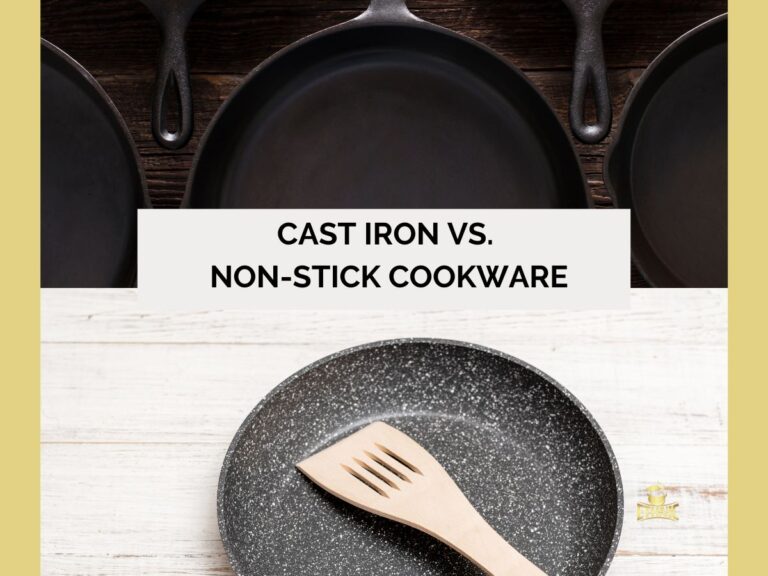Soapstone cookware, known for its ancient roots, has been an integral part of South Indian kitchens for centuries. Renowned for its ability to retain heat, enhance flavors, and maintain the nutritional quality of food, soapstone pots, and pans have gained a resurgence in modern kitchens. At Ethnic Pots and Pans, we believe in preserving tradition by offering high-quality soapstone cookware that’s perfect for authentic, slow-cooked South Indian dishes.
In this guide, we’ll explore 7 traditional South Indian recipes that are best cooked in soapstone cookware. These recipes bring out the unique flavors that soapstone enhances while reflecting the rich culinary heritage of South India.
Traditional Soapstone Cookware Recipes
1. Puliyodarai (Tamarind Rice)
Puliyodarai, or Tamarind Rice, is a staple in many South Indian homes and temples. Cooking it in soapstone cookware ensures that the tamarind flavor is slowly infused into the rice, giving it a deep, rich taste.
Ingredients:
– 1 cup cooked rice
– 1 lemon-sized ball of tamarind
– 2 tablespoons sesame oil
– 1 tablespoon mustard seeds
– 2 dried red chilies
– 1 tablespoon chana dal
– 1 tablespoon urad dal
– 2 tablespoons peanuts
– A pinch of asafoetida
– Salt to taste
– Curry leaves
Instructions:
1. Soak the tamarind in warm water and extract the juice.
2. In your Ethnic Pots and Pans Soapstone Pot, heat sesame oil and add mustard seeds, dried red chilies, chana dal, urad dal, and peanuts. Sauté until the dals turn golden.
3. Add the tamarind extract, asafoetida, curry leaves, and salt. Simmer the mixture until it thickens.
4. Add the cooked rice to the pot and gently mix, allowing the rice to soak up the tamarind mixture. Serve warm.
Why Use Soapstone?
Soapstone’s even heat distribution ensures that the tamarind sauce slowly permeates the rice, enhancing its flavor without burning.
-
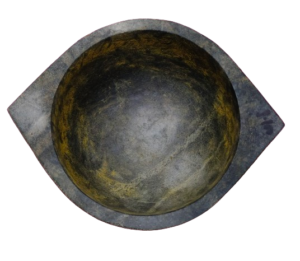
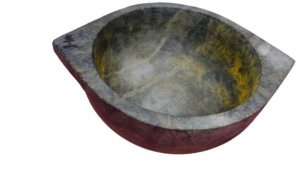 Pre-seasoned soapstone kadaai/kalsatty kadaai₹1,700.00 – ₹3,500.00
Pre-seasoned soapstone kadaai/kalsatty kadaai₹1,700.00 – ₹3,500.00 -
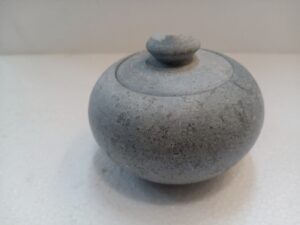
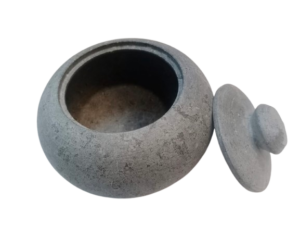 Soapstone curd pot apple shape₹1,600.00 – ₹2,200.00
Soapstone curd pot apple shape₹1,600.00 – ₹2,200.00 -
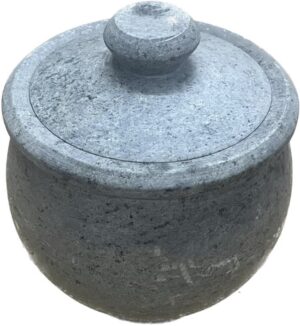
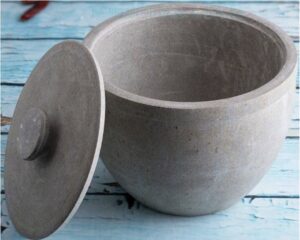 Soapstone curd pot pear shape₹1,100.00 – ₹2,100.00
Soapstone curd pot pear shape₹1,100.00 – ₹2,100.00 -
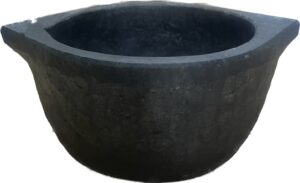
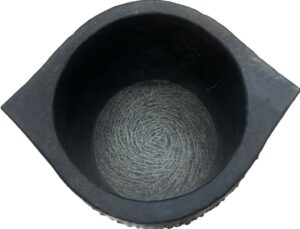 Pre-seasoned soapstone kadaai/kalsatty₹1,700.00 – ₹3,500.00
Pre-seasoned soapstone kadaai/kalsatty₹1,700.00 – ₹3,500.00 -
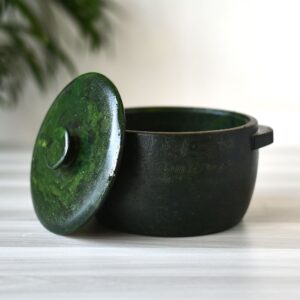
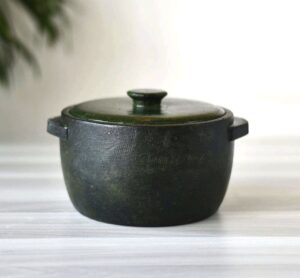 Pre-seasoned soapstone kadaai with lid₹2,000.00 – ₹4,500.00
Pre-seasoned soapstone kadaai with lid₹2,000.00 – ₹4,500.00
2. Kootu (Vegetable Lentil Stew)
Kootu is a comforting South Indian dish made with lentils and vegetables. Cooking this stew in a soapstone pot allows the flavors of the spices, vegetables, and lentils to merge beautifully.
Ingredients:
– 1 cup yellow moong dal
– 1 cup chopped vegetables (like pumpkin, ash gourd, or snake gourd)
– 1 teaspoon cumin seeds
– 1 teaspoon mustard seeds
– 2 dried red chilies
– A few curry leaves
– 1 tablespoon coconut oil
– Salt to taste
– Freshly grated coconut for garnish
Instructions:
1. Cook the moong dal until soft and set aside.
2. In your Ethnic Pots and Pans Soapstone Pot, heat coconut oil and add mustard seeds, cumin seeds, dried red chilies, and curry leaves.
3. Add the chopped vegetables and sauté for a few minutes.
4. Pour the cooked dal into the pot, mix well, and let it simmer for 10 minutes.
5. Garnish with freshly grated coconut and serve with rice.
Why Use Soapstone?
Soapstone retains the heat evenly, allowing the dal and vegetables to slow-cook, enhancing the flavor and keeping the dish nutritious.
3. Morkuzhambu (Buttermilk Curry)
Morkuzhambu is a tangy, spicy buttermilk-based curry that pairs perfectly with steamed rice. Cooking it in a soapstone pot not only enhances the flavor but also maintains the heat longer, making it a traditional favorite for slow cooking.
Ingredients:
– 1 cup buttermilk
– 1/4 cup grated coconut
– 1 teaspoon cumin seeds
– 2 green chilies
– 1 teaspoon turmeric powder
– Salt to taste
– 1 tablespoon coconut oil
– 1 teaspoon mustard seeds
– A pinch of asafoetida
– A few curry leaves
Instructions:
1. Grind grated coconut, cumin seeds, and green chilies into a smooth paste.
2. In your Ethnic Pots and Pans Soapstone Pot, heat coconut oil and add mustard seeds, asafoetida, and curry leaves.
3. Add the coconut paste and sauté for a minute. Pour in the buttermilk, turmeric powder, and salt.
4. Simmer gently without bringing the mixture to a boil. Serve hot with rice.
Why Use Soapstone?
Soapstone’s natural heat retention ensures that the buttermilk doesn’t curdle while keeping the curry warm for a longer time.
4. Avial (Mixed Vegetable Coconut Stew)
Avial is a quintessential Kerala dish made with a mix of vegetables cooked in a coconut paste. The gentle heat distribution of soapstone cookware ensures that the vegetables remain tender without losing their shape or flavor.
Ingredients:
– 1 cup mixed vegetables (carrot, yam, beans, drumstick)
– 1/2 cup grated coconut
– 1 green chili
– 1 teaspoon cumin seeds
– A few curry leaves
– 1 tablespoon coconut oil
– Salt to taste
– A pinch of turmeric
Instructions:
1. Boil the mixed vegetables with turmeric and salt until just tender.
2. Grind the coconut, green chili, and cumin seeds into a coarse paste.
3. In your Ethnic Pots and Pans Soapstone Pot, combine the boiled vegetables with the coconut paste and gently heat.
4. Drizzle with coconut oil and garnish with curry leaves. Serve with rice or roti.
Why Use Soapstone?
The even heat from the soapstone pot ensures the vegetables are perfectly cooked, absorbing the coconut flavor without becoming too soft.
5. Vatha Kuzhambu (Tamarind Stew)
Vatha Kuzhambu is a tangy tamarind-based curry often made with sundried turkey berries (vathal). Cooking it in soapstone brings out the rich, earthy flavors and allows the stew to thicken naturally.
Ingredients:
– 1 lemon-sized ball of tamarind
– 1 tablespoon sesame oil
– 1 teaspoon mustard seeds
– 1 teaspoon fenugreek seeds
– 2 dried red chilies
– 1 teaspoon sambar powder
– A few curry leaves
– Salt to taste
– 1 tablespoon sundried vathal (optional)
Instructions:
1. Soak tamarind in warm water and extract the juice.
2. In your Ethnic Pots and Pans Soapstone Pot, heat sesame oil and add mustard seeds, fenugreek seeds, dried red chilies, and curry leaves.
3. Add the tamarind juice, sambar powder, vathal, and salt. Simmer the mixture until it thickens.
4. Serve with hot rice and papad.
Why Use Soapstone?
Soapstone cookware allows for slow simmering, which enhances the tangy flavors of the tamarind and spices.
6. Pongal (Savory Rice and Lentil Porridge)
Pongal is a savory rice and lentil dish that’s a staple for South Indian breakfasts. Soapstone cookware’s heat retention makes it ideal for preparing pongal, keeping it warm for longer.
Ingredients:
– 1 cup raw rice
– 1/2 cup split yellow moong dal
– 1 tablespoon ghee
– 1 teaspoon black pepper
– 1 teaspoon cumin seeds
– A few curry leaves
– 1 tablespoon cashews
– Salt to taste
Instructions:
1. Cook rice and moong dal together until soft.
2. In your Ethnic Pots and Pans Soapstone Pot, heat ghee and fry pepper, cumin seeds, curry leaves, and cashews.
3. Add the cooked rice-dal mixture and mix well. Serve with coconut chutney and sambar.
Why Use Soapstone?
Soapstone’s natural ability to retain heat keeps the pongal warm and soft, perfect for a comforting meal.
7. Rasam
Rasam, a tangy and spicy South Indian soup, is traditionally slow-cooked to allow the spices to infuse the tamarind broth. Cooking rasam in a soapstone pot enhances its flavor, giving it a more earthy, rich taste.
Ingredients:
– 1 lemon-sized ball of tamarind
– 1 tomato, chopped
– 1 teaspoon cumin seeds
– 1 teaspoon mustard seeds
– 1 teaspoon black pepper
– A pinch of asafoetida
– A few curry leaves
– 1 tablespoon ghee
– Salt to taste
Instructions:
1. Soak tamarind in water and extract the juice.
2. In your Ethnic Pots and Pans Soapstone Pot, heat ghee and add mustard seeds, cumin seeds, black pepper, curry leaves, and asafoetida.
3. Add the tamarind juice, chopped tomatoes, and salt. Simmer for 10 minutes and serve hot with rice.
Why Use Soapstone?
The even cooking in soapstone ensures that the rasam retains its tangy flavor while balancing the spices beautifully.
Conclusion
Soapstone cookware, with its natural heat retention and flavor-enhancing properties, is perfect for preparing traditional South Indian dishes. At Ethnic Pots and Pans, our soapstone cookware ensures that these recipes turn out authentically delicious every time. Whether you’re simmering rasam or cooking pongal, soapstone helps retain the nutritional value and deep flavors of your food.
By incorporating these traditional these traditional South Indian recipes into your kitchen repertoire, you’re not only enjoying authentic flavors but also the benefits of cooking in natural, non-toxic cookware that stands the test of time. Embrace the charm of soapstone cookware and elevate your cooking experience with Ethnic Pots and Pans!






